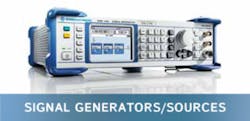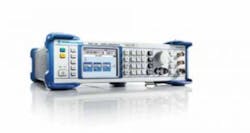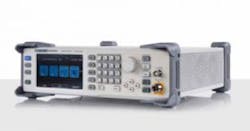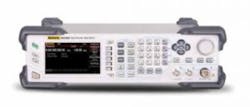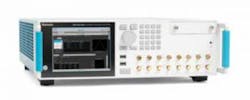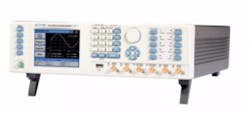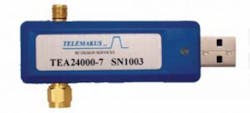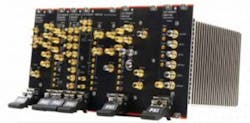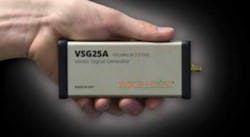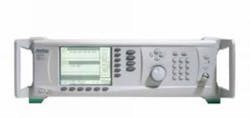Multifunctionality, portability driving signal generator developments
Signal generators are one of the most versatile electronic instruments used, and they can be found in all areas of design, development, production and field tests. Their applications range from base station or radar, to component design, test and production, EMC, or field tests.
Combined with new-age demands, longstanding generator applications such as replicating sensor signals and creating RF make generators a highly valuable piece of equipment. And while the demand for digital signal generators has grown substantially faster than comparative alternatives, signals in analog, ideal or distorted, standard or custom are still important elements for today’s test engineers.
Advantages/disadvantages of different generator types
Today, the rapidly evolutions in the area of wireless technologies such as data-driven LTE, Wi-Fi and 5G has boosted demand for the fastest high-speed serial data signals, giving PXI form factor signal generators a clear advantage in this area, with PXIe modules’ ability to provide customizable measurement solutions for market-specific needs—allowing for adopting new wireless technologies easily and quickly.
Meanwhile, USB configurations have their advantages, too, most notably in portability and handiness, as well as cost. A small USB signal generator the size of a computer mouse typically costs less than $500, and is priceless when something is needed quickly. However, the obvious disadvantage for USB is its limited range and capability, so one may need a more powerful device for some tasks.
“USB instrumentation and PXI modules offer high performance in a small physical package,” said Jason Chonko, applications marketing manager for SIGLENT Technologies North America. “They are both very good in production environments where a display is not required. They do require external computer control and software that complicates their usage, especially for quick spot checks or troubleshooting activities, however.”
Handheld signal generator instrumentation is the most portable solution and optimized for field use, including outdoor and harsh environments. The downside can be with display and layout. “If not designed properly, handhelds can be difficult to work with for long periods of time,” Chonko said, adding that handheld generators tend to come at a price premium due to the research and development for battery operation, and the relatively high cost of components designed for portable applications.
And then there are traditional benchtop instruments, which offer a great blend of portability and ease-of-use coupled with remote control and automation capabilities. Since no computer or software is required for their use, they are ready to work immediately upon powering on, and they can also be designed to include communications buses and drivers to make remote control and automation much easier. The downside here is the comparatively large physical space they take up.
Commenting on benchtop signal generators, Chris Armstrong, director of product marketing and SW strategies at RIGOL Technologies, said, “RIGOL believes in the value of benchtop instruments that can be controlled from the front panel or remotely via USB or LXI. This makes the test solutions robust and flexible in a number of environments even in locations where a PC or controller isn’t convenient. Benchtop instruments can provide reliability and ease of use independent of computer or software control making them advantageous for test setups that need to outlast today’s computer lifecycle.”
Now on the market
No matter the solution format, signal generator providers are constantly innovating to provide test engineers with a variety of types that outperform previous models. Some of these providers specialize in one format or another. We at Evaluation Engineering reached out to many leading companies in this space to find out what new signal generator instruments they have brought to market, and their key features.
RF/Microwave signal generators
Munich, Germany-based Rohde & Schwartz, which has American headquarters in Columbia, SC, has recently introduced RF/microwave signal generators at multiple levels. For performance, there’s the R&S SMA100B analog generator for all applications requiring extremely clean analog signals. It has a frequency range from 8 kHz to 3 GHz, 6 GHz, 12.75 GHz or 20 GHz, and the base unit’s performance can be improved with options.
Three levels of SSB phase noise and three levels of outputpower (standard, high power, and ultra power) can be selected. For mid-range, the compact R&S SMB100B Analog generator also provides various frequency options from 8 kHz to 1 GHz, 3 GHz, and 6 GHz, and can deliver up to 34 dBm of output power (at 1 GHz of carrier frequency) without an external amplifier. It is suitable for radar and receiver tests in the aerospace and defense sector, as well as for CW-based production tests on wireless devices and infrastructure. Also for mid-range, the R&S SMBV100B vector generator is marketed as a perfect combination of performance and usability. It offers ultra high output power, fully calibrated wideband signal generation and intuitive touchscreen operations. Its wide RF modulation bandwidth of up to 500 MHz satisfies requirements of fourth and fifth generation communications standards, and in A&D applications, that bandwidth allows the generation of complex pulsed signals.
Rohde & Schwarz said the three products above are part of a full lineup built on the premise of “instruments without compromise,” aiming to deliver the best RF performance and signal purity along with the highest output power without compromising on one or the other. “This has been a challenge in the industry,” company market segment manager Fairde Akretch said. “Beyond performance, all instruments have a key focus on usability, which has also long been neglected by the industry for signal generators. All these products feature a high-resolution touchscreen and very intuitive GUI, allowing users to quickly set up the instrument with the exact signal they need.”
At Astronics, the company has released a pair of new signal generators recently. Launched in 2017, the SE5082 Abitrary Microwave Generator is a multi-Nyquist zone waveform generator, with output stages that can be customized for signal generation, as well in 2.5 GHz-3 GHz wide bands up to > 15 GHz. And just launched in Q4 of 2018, Astronics’ LS Series (LS3081M/LS6081M/LS1291M) are 3, 6, or 12 GHz analog signal generator modules for modular and multi-channel signal generator system architectures.
The SE5082 generates wideband, arbitrary microwave signals to > 15 GHz with the industry’s highest dynamic range (5-15 GHz) at one-fifth the cost of competing solutions, accoridng to Astronics. It does this by making use of often suppressed Nyquist zones, or high frequency images of the baseband waveform, which are not suppressed, and are in fact amplified to make them available for use. Meanwhile, the LS Series features fast frequency switching (< 100 µs), internal and external analog modulation, and pulse modulation of nearly any pulse width. The small size of 6.3” x 4.7” x 1” makes it useful for low power and mobile applications, and it has USB and SPI control for easy remote operation.
SIGLENT has just released two new RF signal sources: the 2.1 GHz SSG3021X and 3.2 GHz SSG3032X, which are tailored for R&D, production, and rework applications where a stable and easy-to-use RF source is required. “The SSG features tremendous performance, an intuitive touchscreen, and powerful output capabilities for a smaller investment than any competitor,” Chonko said. Those two products were first released in China this past September, and globally in October.
In the fall of 2017, Tektronix released the AWG5200 series arbitrary waveform generator (AWG). The series represents the company’s next generation of high-fidelity performance AWGs, combining 16 bits of resolution with a 10GS/s max sample rate and fitting eight channels in a single 3U instrument. For most advanced applications, AWGs are typically rack-mounted. And in many applications, rackspace can be very limited. Commenting on the AWG5200’s compact ability, Tektronix technical marketing manager David Akerson said, “This is a dramatic improvement over instruments that typically only provide one or two channels in a larger 5U slot.”
While not a dedicated RF or MW signal generator in the traditional sense, the AWG5200 series features a 10GS/s DAC which allows for it to directly generate a 3 GHz output on each of up to eight synchronized output channels. The AWG5200 series lowers the cost of ownership for complex multi-signal environments with a list price of about $11,000 per channel, and the company said the 16-bit vertical resolution is the best fully-integrated AWG available in the industry, compared to alternatives at 14-bits resolution.
“Engineers developing radar/EW systems and components require high-fidelity, tightly synchronized multichannel signal generation to stimulate radar receivers for design, troubleshooting and operational testing,” Akerson said. “The AWG5200 provides better than 10 ps channel to channel skew across its eight channels. Each of the AWG5200’s channels has independent paths out, individual amplification, separate sequencing, up-conversion, dedicated memory and can be controlled independently without cross talk or limitations on any channel’s performance.”
Akerson went on to say the series’ level of independence and flexibility—along with less than 2 µs latency and fast rise times—make the AWG5200 an excellent source for generating complex, real-world environments, testing phased arrays, simulating objects of interest, or replacing older equipment with new commercial off-the-shelf solutions.
Fairport, NY-based Saelig has recently introduced a variety of RF signal generators. One of them is the Windfreak SynthHD PRO 54MHz to 13.6 GHz Dual Channel Microwave Generator. The SynthHD PRO is a compact temperature-compensated, dual-channel, software-tunable RF signal generator and frequency sweeper, controlled and powered via a USB port on a device running Windows or Android software. The SynthHD PRO’s dual, independent, 54 MHz – 13.6 GHz channels can be configured to run at two different frequencies, or at the same frequency with different phases. This allows its use in antenna beam steering applications or quadrature signal generation commonly used in image-reject frequency conversion. The SynthHD PRO also has nonvolatile on-board memory, so it can be programmed to start up by itself on any frequency, power, sweep, or modulation setting (or combinations thereof) to run stand-alone in field use.
Saelig also has three USB format generators. The Telemakus TEG24000-6 21GHz – 24 GHz USB synthesized series of stick-sized generators can be used as separate components to enhance or replace existing test components, or they can be used together to create an entire test system, making them suitable for putting in your pocket for fieldwork using a laptop. The Aaronia BPSG4 USB Signal Generator (35MHz to 4.4GHz) is a compact and portable (battery-powered, standalone) RF signal generator up to 4,4GHz, which the company touts as cost-effective. It generates up to + 17dBm output power, runs up to four hours in battery operation, and can be programmed with intelligent batch profiles. According to Saelig, it is the world’s smallest battery-powered and intelligent stand-alone RF generator up to 4.4GHz. The Aronia BPsG4 USB can be used as a mini RF frequency and power level calibrator. Finally for Saelig, there’s the GWInstek USG-LF44 35MHz – 4.4GHz USB RF Signal Generator series of pocket-sized instruments come in five models from 35 MHz to 4400 MHz. The USG Series provides continuous wave signal outputs, but no signal modulation function. The built-in electronic attenuator allows adjustable power range from -30 dBm to 0 dBm. The USG-Series has several operational modes: fixed frequency, frequency sweep, frequency hopping, and power sweep. USG-Series signal generators can be used as the tracking generator for the GSP-730 spectrum analyzer to conduct measurement functions of scalar network analyzers.
“Windfreak RF generators can be used as RF building blocks in other equipment,” said Alan Lowne, Saelig owner and CEO. “These devices can be used as complete RF test and measurement equipment controlled by Labview in an ATE setup, or used as bolt-in RF modules in RF communications equipment. All products have innovative, powerful feature sets controlled by internal microprocessors so any settings can be memorized and used with or without a PC. Windfreak hardware also comes with the Labview GUI source code, saving the end user hundreds of hours programming custom software.”
At the end of September, Keysight introduced the M9410A/M9411A PXIe vector transceiver (VXT), which integrates a 6-GHz vector signal generator (VSG) and a vector signal analyzer (VSA) in a 2- or 3-slot PXIe module. It addresses the test demands of the latest 5G New Radio (NR) and incorporates RF hardware performance, modular instrumentation, and trusted measurement applications. With the M1740A mmWave head, frequency ranges can be extended to mmWave.
Also new from Keysight is its M9383A PXIe Microwave Signal Generator, which is a compact modular instrument that provides frequency coverage from 1 MHz to 44 GHz, up to 1 GHz modulation bandwidth with an internal baseband generator, and over 2 GHz RF modulation bandwidth with external I/Q inputs. Based on the PXIe industry standard, the M9383A is highly configurable and expandable. The smallest configuration—a 20 GHz analog signal generator—can be used in simple LO or blocking applications, and the largest configuration, a 44 GHz vector signal generator, can be used for 5G applications.
Over at Signal Hound, its VSG25A Vector Signal Generator is a couple years old, but the company said engineers are still discovering it due to its low cost and small USB-powered form factor. The VSG25A comes with a simple interface software specific to the device for tone selection, modulation rate, and depth. The software generates AM/FM, Pulse, and a selection of PSK and QAM signals, among a variety of others. The software also includes a handy, documented API for controlling the VSG25A via custom applications written in Java, C#, Python, C++, MATLAB, or LabVIEW.
“Our VSG25A is an extremely low-cost way of effectively creating 100 MHz of signal noise, in a variety of formats, connected and powered by USB,” said Cory Allen, Signal Hound marketing director. “For situations needing a simple and quick signal injection, it’s hard to beat for the price. Oh, and it’s about as big as your mobile phone.”
At RIGOL, its newest RF signal generators include the DSG800 and DSG3000 families that generate signals up to 6 GHz. The company continues to expand capabilities in RF applications, which recently involve real-time spectrum analyzers. The DSG3000 family can be configured to output complex IQ signals important to many real-time tests. This past September, RIGOL launched high-resolution arbitrary waveform generators that can be used as a high-resolution baseband generator together with the DSG3000 to build more precise IQ signals.
“RIGOL continues to enhance our value to RF engineers with expanding product and application coverage,” Armstrong said. “RIGOL’s RF generators are accurate and reliable broad-purpose instruments. This capability makes them well suited to debugging and analysis applications, while their value makes them affordable for engineers from training and education to R&D. This flexibility, capability, and value provide a unique solution to engineers looking for ways to save time and money in RF test.”
And at Anritsu, while it hasn’t released any new RF/microwave signal generators recently, the company said its MG3690C analog instrument series still provides the performance necessary to meet many of the signal source demands associated with emerging applications such as IoT and 5G, as well as military/defense. The series covers audio, HF, VHF, UHF, RF, and microwave frequencies from 0.1 Hz to 70 GHz in a single coaxial output and beyond 500 GHz with external multipliers. This means that engineers can work in the audio spectrum, test and validate IoT designs in low frequency bands, and create test systems for 5G in the microwave and millimeter wave bands using one synthesizer.
Charles Tumbaga, Anritsu’s MG3690C product manager, said, “This capability allows engineers to accurately verify high-power designs. With excellent phase noise, fast frequency-switching speeds, and a full suite of analog modulation capability, the MG3690C series is an ideal signal source for design and manufacturing test of components and systems for a wide variety of industries—including wireless communications, aerospace and defense, and consumer and computer electronics.”
Multifunction instruments
Multifunction signal instruments can combine signal-generation capabilities with functions such as oscilloscope, DMM, or signal analysis. With integrated circuits and devices’ complexity increasing, many R&D engineers are looking at a specific test solution, rather than an individual test instrument. This makes multifunction instruments very valuable.
An example of this is Keysight’s M9410A PXIe Vector Transceiver, which integrates a VSA and a VSG in a 2-slot PXI module. The 3-slot mode, M9411A, adds optical I/O interface to stream I/Q waveform data to/from the DUT and the built-in FPGA to customize proprietary signal processing for extended applications. Integrating the specific functions extends more test capabilities for modern complicated wireless devices.
“For specific applications, combining capabilities is a great benefit to engineers,” Armstrong said, adding that RIGOL’s newest oscilloscopes combine a digital voltmeter and lower-speed signal generators (up to 20 MHz), which are useful for baseband RF testing and time domain signal emulation. “With enhanced 1 million point FFTs, as well as a color spectrum density view and peak markers these oscilloscopes are well suited to many RF analysis applications.”
Astronics’ multifunction solutions include the CTS-6010 Portable Radio Test Set and the ATS-3100 RTS Benchtop Radio Test Set. Both platforms provide a highly integrated, synthetic instrument approach that meet the challenging demands of the diverse applications in communications test.
Tektronix recently released the MDO3000 mixed domain oscilloscope, which is available with an optional AWG. It provides 13 predefined waveform types, 50 MHz waveform generation, 128 k arbitrary generator record length and 250 MS/s arbitrary generator sample rate. It offers the convenience of an all-in-one instrument, a familiar user interface, and saves bench space.
Software
What software packages do these leading vendors offer to complement their signal-generator products?
At Rohde & Schwartz, Akretch said the company has a very large selection of software upgrade options that are made to tailor each signal generator to the customer application. They include identities and support for most digital standards, RF options such as phase coherence, pulse generator, pulse modulator or pulse sequencer, baseband options and baseband enhancements, analog modulation options, and many more. Meanwhile, performance upgrades for frequency, output power, reference oscillator, and other options are offered in either key-code or hardware.
Over at Keysight, its new RF signal source products support Signal Studio for waveform creation. Signal Studio is a signal creation application software that runs on a PC, including a suite of flexible and easy-to-use signal creation tools that provide validated and performance-optimized reference signals for commonly used communications standards. It configures signals in an application-specific graphical interface and enables users to scale the capability and performance to meet their specific test needs. For simulation and prototyping, Keysight’s SystemVue is a system-level EDA software platform for designing communications and defense systems, while Matlab offers interactive tools and command-line functions for instrument control and data analysis tasks such as signal processing, signal modulation, and digital filtering. Keysight also offers PathWave Solutions, a new design and test software platform that accelerates product development workflow from concept through manufacturing and deployment.
For Astronics, both its SE and LS products are provided with drivers for use with LabVIEW, Python, C++, MATLAB, CVI/C++ and VB. The SE is provided with a waveform design and control GUI, while the LS is provided with a signal generator GUI. Optionally, the SE5082 is provided with inverse sine(x)/x digital filter software which allows it to produce flat arbitrary waveforms in any Nyquist zone.
At RIGOL, its free Ultra IQ Station software is utilized by RF generators configured to generate IQ signals. Ultra IQ Station includes power ramping, multicarrier CW, and a number of customizable digital modulation schemes that include QAM, PSK, FSK, and more. It can also generate custom data lists and modulation maps for research into new modulation strategies. “This software defines, builds, and sends IQ waveforms to the instrument for generation,” Armstrong said. “Similarly, complex waveforms are built for our baseband arbitrary waveform generators in Ultra Station. With Ultra Station and Ultra IQ Station engineers have complete control over their baseband sources, modulation inputs, and IQ outputs from scheme to data.”
Market outlook
In September, market research firm Research Nester released a report estimating that the global signal generators market will grow at a rapid compound annual growth rate of 8.52% over the period from 2017-2027.1 That mark compares slightly lower than the 10.4% CAGR for the 2013-2018 period that MarketsandMarkets released back in July 2013.2
“Rapid adoption of signal generators with advanced technologies in industries such as telecommunication, aerospace & defense, electronics manufacturing, industrial, automotive, medical sector and education are expected to spur the market growth of signal generator globally,” Research Nester’s report stated, adding that North America is expected to be the fastest-growing market of signal generators due to the high rate of adoption of advanced technologies among consumers. The report said Asia Pacific currently holds the largest market share of revenue due to the wide use of technologies such as Bluetooth and wireless services among consumers, and that digital modulation technology will lead to arbitrary wave signal generator growth in that region. For Europe, the report said the region is expected to show lucrative growth during the forecast period due to the growing use of advanced communication systems such as Wi-Fi and LTE.
“Innovations in wireless and signal transferring technology along with the introduction of fast processors led to the introduction of few smart devices into the market,” Research Nester explained. “This, in turn, is expected to bolster the demand for signal generators as it helps to test the current flow in internal circuits. Increase in the use of sensors and new technologies into electronic products such as smartphones, washing machines and microwave ovens spur the growth of signal generators market globally.”
References
About the Author

